Landscaping with railroad ties: 10 clever ways to use this versatile material
Whether you prefer a rustic or contemporary design, landscaping with railroad ties is a smart choice for yards big or small
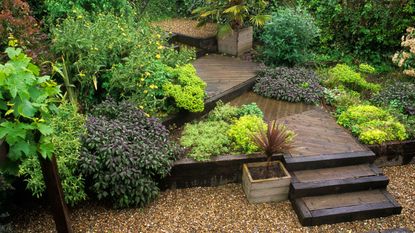

Landscaping with railroad ties is a popular choice for many backyard projects thanks to their naturally attractive worn appearance. They're a thick, rugged and affordable type of wood that can be used to form long-lasting barriers for edging beds, and making planters, paths and walls, as well as being good for more ambitious landscaping and decking projects.
Railroad ties come in various sizes in both reclaimed and new softwood and hardwood. Reclaimed railroad ties have generally been used to support railroad lines and have a worn appearance which makes them ideal for bringing a traditional rustic and weathered look to your yard. New, square-edged ties in either softwood or hardwood are much smoother and generally suited to more contemporary garden designs.
Railroad ties will easily slot into your landscaping ideas and look like they've been there for ever. They look particularly fine combined with gravel, rocks and boulders, as well as mixed in with shrubs and trees.
10 clever options for landscaping with railroad ties
Using railroad ties in garden landscaping projects has become a real trend. They grab your attention which makes them the perfect hard landscaping material.
The aged wood gives an aesthetically appealing and natural quality to your yard. You could even try using them in your front yard landscaping ideas as a springboard for your driveway and flower bed designs.
1. Design some garden steps with railroad ties
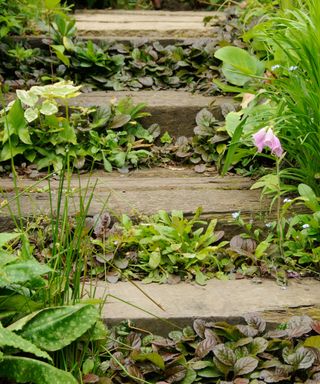
Create a rustic looking set of garden steps
Whether new or old, railroad ties make a great set of rustic looking garden steps. Easy to install, it's a no-hassle, simple alternative to concrete or pavers, and is a great cheap landscaping idea.
Layering in planting between the railroad tie steps helps to create more of an established look. Ajuga (‘Bugle’) is an attractive mat-forming, evergreen perennial. Its oval-shaped glossy deep bronze-purple leaves soon spread, so it's an ideal plant for covering terraces, banks and slopes. Encourage a mix of other plants to grow within the surrounding gaps and crevices of your steps too.
Railroad tie garden steps are popular with landscape designers, who also turn them into much grander 'stairs' and tie them in with other elements as part of the landscaping scheme.
2. Use railroad ties to make smart vegetable beds
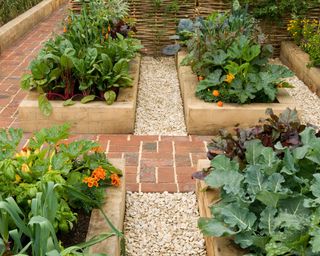
Railroad ties are an effective solution for a smart kitchen garden
One of the most popular options for landscaping with railroad ties is to use them for building simple raised garden beds. The solid wood keeps soil contained and acts as a barrier to keep pests such as slugs out. Perfect for drainage, they also protect against encroaching weeds.
There are concerns about the safety of using creosoted railroad ties for kitchen gardens. Since creosote can leach out into the soil, many people say that you should never use railroad ties for surrounding a vegetable garden. So be careful what you pick up from salvage yards.
If a railroad tie is old and worn though, the chance of leaching is minimal. Whether or not plants actually take up creosote in the soil is also not established for sure. For safety, consider lining your garden beds with plastic as a precaution to stop the wood from contacting the soil.
There are plenty of other options though if you love the idea of landscaping with timber for your veg plot, including buying new untreated timber.
3. Make a garden bench and matching table
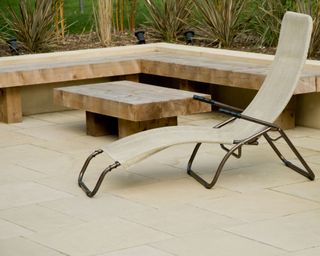
Get creative and make your own outdoor furniture
If you're handy with a drill and love DIY outdoor furniture ideas, why not try building your own customized garden furniture with railroad ties? Adding a rustic garden bench and low table using reclaimed railroad ties is an easy build that you can complete in a couple of hours. It will look great without needing a big outlay.
If you prefer, choose new untreated ties for a sleeker, more modern look. There are loads of options for your DIY outdoor bench ideas, including designs made of old wooden pallets as well as different types of timber, so you can personalize your space exactly how you want it.
4. Construct a retaining wall from railroad ties
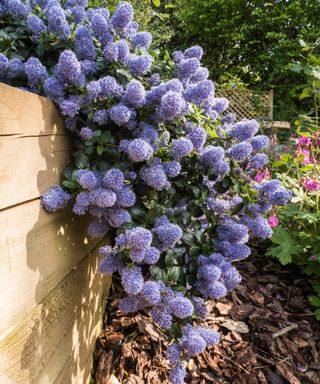
Railroad ties are a budget-friendly choice for garden walls
Using these timbers to build a retaining wall is one of the most popular projects when landscaping with railroad ties. They are a good alternative to bricks or concrete as not only do they look good but they're often a more affordable option too.
Railroad ties can be used both horizontally and vertically when building a wall. Using sleepers horizontally is more common when constructing a low-level garden wall.
For terraced gardens, the method you choose for construction should be determined by the height of the bed or bank that you wish to retain.
If you're interested in landscaping with flowers too, the impressive blue shrub tumbling over this wall is a ceanothus (California lilac). It's worth remembering that these look particularly good growing against a sunny, sheltered wall.
5. Plan a rustic deck
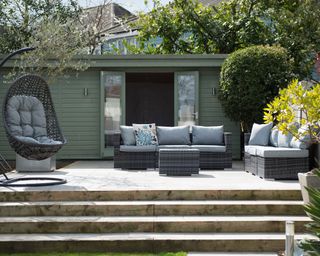
If you love a DIY project, railroad ties are ideal for the structure of a raised deck
If you fancy a big garden makeover to switch up the look of your outdoor space, think about upgrading your decking ideas. Landscaping with railroad ties offers a natural-looking addition to your yard and is a great alternative to decking boards.
If you’re starting from scratch or doing a makeover on an existing deck, railroad ties are an excellent material for building up the platform and creating neat edges for a raised decking area as well as tiered steps. Use new rather than used railroad ties for this type of project especially if you want to include steps, low walls and balustrades to enclose the space.
Practical and durable, it will give you a cost-effective solution that is long-lasting and looks good too.
6. Rustle up some simple raised beds
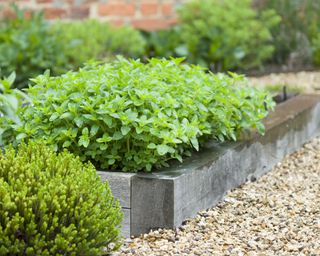
Make an area for growing your own fruit and veg
There are many benefits to introducing raised beds in your garden to grow a wide range of plants, fruit and vegetables, including making your crops easily accessible as well as protecting them from creatures that will nibble on them.
Learning how to build a raised garden bed from railroad ties is a relatively easy DIY project, especially if the pieces of timber are pre-cut to length. Buy pressure-treated wood as it will last for many years and treat it with wood preservative before you start.
There are many types of railway ties and lookalikes on the market that all have their own characteristics, but always be aware that some may contain unpleasant chemicals. You can also get the look with made-to-measure raised beds but these usually end up being a much more expensive choice.
7. Use railroad ties as landscape edging
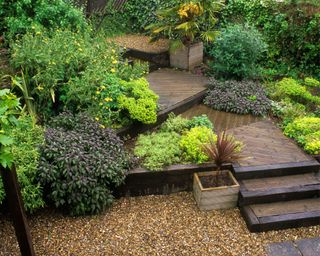
Use railroad ties throughout your plot to unify the space
If you're looking for stylish garden edging ideas, railroad ties are a smart choice. As well as looking good, using them for edging is practical, too. It helps to define different zones in your garden while keeping soil, gravel, wood chips, plants and lawn all firmly in their place.
In addition, you can landscape with railroad ties to edge steps, patios and decks, and garden paths. The greatest advantage of using ties when it comes to projects like this is, of course, their ruggedness. It doesn’t generally require any complex planning, design or prepping either as railroad ties offer an easy and practical way to define the edges of your garden just as they are.
8. Channel a rustic vibe with a woodland garden
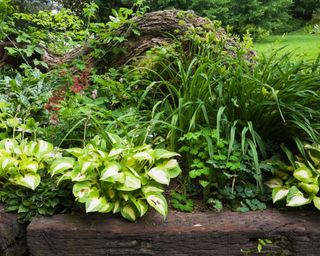
Weathered timber gives any space a more rustic vibe
If you love woodland plants for gardens you're in the right place as weathered looking railroad ties will add the perfect finishing touch to your planting scheme. Use them to define the outline of the bed or purely for ornamental purposes as they fit right in with their timeworn good looks.
It's a great way of landscaping around trees too. Use railroad ties to build a rectangular base to frame the trunk. If you're clever and build it high enough this can also be used to create seating.
9. Landscape railroad ties into a sensory garden
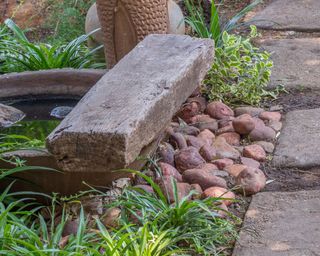
Railroad ties are a really simple way to introduce texture and interest
If you love the idea of creating a sensory garden a pond is a must as it's one of the best places to immerse yourself in nature. It doesn't have to be a big pond either to feel the benefits.
Add some smooth pebbles and a weathered railroad tie to sit on and you introduce some texture into the mix too. It will soon become a favorite spot for moments of quiet contemplation.
10. Choose railroad ties to add a real wow moment
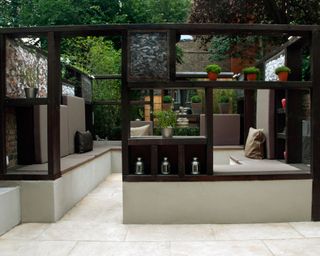
Create larger structures from this practical type of timber
Sometimes it pays to think outside the box and come up with something unique. Landscaping with railroad ties is an option for more ambitious projects too, like this sleek urban courtyard design that features a pergola, seating and shelving made with railroad ties that have been given a cool modern makeover.
The timber is stained black for a contemporary feel and it's a great example of how you can get creative with modern garden ideas to come up with something truly impressive that's both practical and looks good too.
Why not familiarize yourself with the key landscape design principles to make sure you really get the most out of your space?
Is it easy to buy railroad ties?
There is a range of varieties of railway ties available to buy from specialist suppliers and online. Depending on where you live, original reclaimed railway sleepers that are treated with creosote tend to be no longer available as creosote is packed with chemicals so best avoided for home DIY projects especially things like vegetable garden beds and other projects featuring edibles such as herb gardens.
New untreated railroad tie lookalikes in durable hardwood and softwood are widely available. The wood appears more natural and can vary in color from light brown to grey. As well as being in better condition than reclaimed railroad ties, new ones are available in a much larger choice of sizes and can be cut to fit before you buy.

Lifestyle journalist Sarah Wilson has been writing about gardens since 2015. She's written for Gardeningetc.com, Livingetc, Homes & Gardens, Easy Gardens and Modern Gardens magazines. Having studied introductory garden and landscape design, she is currently putting the skills learned to good use in her own space where the dream is establishing a cutting garden.
-
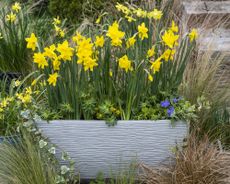 An Update on Gardeningetc
An Update on GardeningetcA word from our publisher
By Beth Murton Published
-
 Do you need to chit potatoes? Find out what the experts say
Do you need to chit potatoes? Find out what the experts sayGrow Your Own Learn how to chit potatoes before planting them in the ground and you’ll be on your way to getting an earlier and bigger harvest
By Drew Swainston Published
